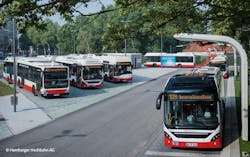Intelligent Charging Management: An Essential Requirement for Operating Electric Buses
Electromobility is currently one of the most debated issues in public transit, not least because electric vehicles allow for the fulfillment of political goals and legal requirements in reducing carbon dioxide emissions. However, despite the euphoria, transit agencies must deal with certain important issues, such as whether switching to electric vehicles is going to be financially viable and what infrastructure needs to be put in place to ensure their practical feasibility on bus routes.
An ideal environment for electric vehicles is generally one which is relatively predictable and follows a regular schedule with overall high mileage. These basic requirements make public transit buses ideal candidates. A city bus covers an average of 140 miles per day. According to manufacturers, a battery’s capacity can now last for a distance of 60 to 200 miles between charges. Therefore, a city bus even today and certainly in the near future could manage short routes without requiring any charging infrastructure on its route — at least as a tendency.
If so, the vehicle can be charged at the depot, generally overnight, or, if necessary, as a top-up at a quiet time during the day. This reduces the investment required for infrastructure and minimizes the operational complexity; if the vehicle needs to charge too often, efficient scheduling may be difficult to plan.
Factors that affect efficient charging management
With a greater number of electric buses in the fleet there is an increase in the effort required to coordinate charging processes. A large amount of power needs to be supplied to a large number of vehicles in a relatively short period of time. In addition to technical and operational requirements, financial aspects must also be considered to enable the entire fleet to be charged efficiently. Several conditions need to be met:
- The buses must be available for pull-out on time and at the right temperature.
- There must be sufficient power for the entire fleet.
- Connections must be available for each vehicle for the process to be managed in parallel and centrally.
- The total load must be balanced in the grid to avoid expensive load peaks.
- Charging should be as easy on the battery as possible.
Moreover, it needs to be considered that other work needs to be done to the vehicles when they are in the depot, which is why they are not available for charging at all times. In addition, the duration of charging processes is not only determined by the maximum connection power, but also depends on the vehicle itself and the ambient temperature.
Central charging management
A central charging management system is required to meet the challenges of electromobility for parallel, controlled and automated charging processes in the depot. Linking vehicles, charging points, power supply and operational information systems in the most suitable way is the goal. Operational information systems such as the planning and scheduling system, depot management system or the Intermodal Transport Control System (ITCS) supply the charging management system with the information it requires, such as the estimated time of arrival of the vehicle, the time available for charging, the scheduled pull-out time of the following day, including circulation information, or the current charging status of the battery. The charging management system uses this information to calculate the charging requirements of each vehicle and optimizes the charging process for the entire fleet.
Intelligent charging management can avoid expensive peak loads on the grid. The charging management system automatically controls charging processes by assigning time slots for charging to each vehicle and monitors their progress. If necessary, the charging sequence is adjusted and cyclically updated. Availability, and more importantly, fluctuations in energy, can be taken into account if the power supplier is integrated into the system.
Standardization
The large number of vehicle manufacturers, individual components and operational information systems which have to work together in a centrally controlled charging management system require a high level of networking in the overall architecture. As transport companies generally aim to maintain a certain level of independence from individual suppliers, standard interfaces are an essential requirement for interoperability. Three interfaces in particular should be looked at:
1. The interface between the vehicle and operational IT during service
Although for many years public buses equipped with onboard computers have been linked to efficient background systems, there is either no link or only a rudimentary one between these and vehicle electronics. As a result, operational information is centrally available, such as the vehicle’s location, up-to-date information about early arrivals or delays or the remaining distance for the day, but dealing with vehicle information is not that common. SAE J1939 is a solid basis for gathering electromobility-related data as well.
2. The interface between the vehicle and the charging point during charging
ISO15118 is a standard for charging communications between the vehicle and the charging device which is well advanced. Basic smart features, such as time-controlled charging, plug & charge or charging management are regulated — driven by the automobile industry — and also applicable for buses. Subsequent work is required if special features are to be implemented, such as preconditioning.
3. The interface between charging point and central charging management
The Open Charge Point Protocol (OCPP), currently in version 1.6, is prevalent. It is typically used between charging points and central institutions which allow and bill for charging but can also start or stop charging remotely. The two latter protocols mentioned have approached the charging process from different angles, roughly at the same time and independently of each other, and in their current versions. As a result they are not yet completely compatible. This is expected to improve significantly in OCPP v 2.0 — which is the most recent version to date.
To summarize, in the area of standardized interfaces, there is still work to be done. However, there is already a substantial basis for smart charging management.
Summary
The implementation of electromobility in public transit faces challenges not only of limited range, but also of charging management. Balancing the pressure on the grid to avoid peaks, charging vehicles carefully and making them available for duty in adequate time are important goals. The solution is a central charging management system which links the vehicles, charging infrastructure, operational IT and energy supplier, and which plans, monitors and optimizes all charging processes.
MOBILE -ECO2
The software suite MOBILE-ECO2 by INIT covers several technical applications which take advantage of a very close link to the vehicle. MOBILEvhm monitors a vehicle’s status during operation, avoids unplanned downtime and increases availability. MOBILEefficiency analyzes driving behavior with regard to safety and fuel efficiency and offers optimization support. The latest addition to the suite is MOBILEcharge, the application for intelligent charging of electric buses. It forms a central control and monitoring instance between the charging infrastructure, vehicles, power suppliers and systems in the depot.
Heiko Bauer is the general manager of CarMedialab. This post first appeared on www.initse.com at https://www.initse.com/ende/news-events/knowledge-database/articles/2018/intelligent-charging-in-the-depot.html.




